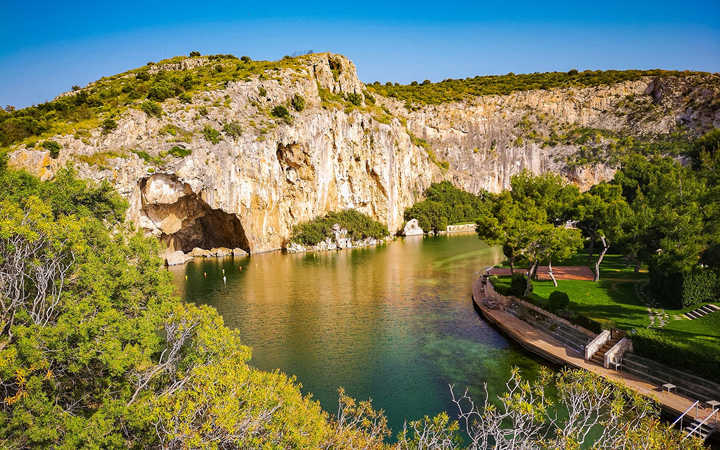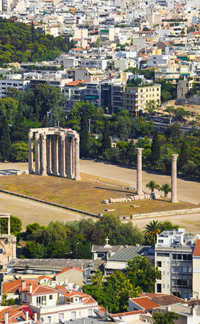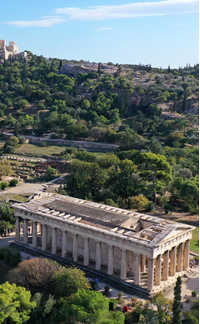Lake Vouliagmeni is located on the southern coast of Attica, just 21 km from central Athens, and lies only 100 meters from the sea. Surrounded by dramatic cliffs and lush greenery, this hidden gem offers a stunning landscape and a unique geothermal experience.
A Lake Steeped in Legend and Mystery
Women leisurely soaking in the warm waters of Lake Vouliagmeni may be unaware of the local legend claiming a mermaid lives in its depths, luring young men to the bottom. What they do know, however, is the water’s healing power — making the lake a year-round destination for therapeutic bathing.
Just a few kilometers from Greece’s capital, the scenery suddenly transforms into a natural paradise. Beneath the surface lies a network of underwater caves, tunnels, and karst formations — typical of limestone-rich regions.
Surprisingly, despite its proximity to Athens, the lake is never mentioned in ancient texts. Historians and archaeologists have found no references to it, and the area’s original name, "Zoster" (meaning "belt"), relates instead to the shape of the bay. A temple to Apollo Zoster once stood nearby, founded in the 6th century BC.
Geologists now believe the lake formed much later, possibly in early Christian times, after an earthquake caused the roof of a massive underground cave to collapse. During the Ottoman era, it was known as "Vouliasmenos" or "Karachi" — meaning "black water."
Thermal Springs and Healing Waters
In 1889, chemistry professor Anastasios Christomanos was the first to document the lake’s unique properties, noting its healing mineral composition. The hot springs lie just 50 meters from the shore and about 40 meters below sea level on the Athens–Sounion road. Water temperatures remain constant year-round, between 20°C and 27°C (68°F to 80°F), rich in minerals and sulfur compounds.
These natural thermal baths are said to aid in the treatment of rheumatism, gynecological and skin conditions, arthritis, joint pain, eczema, and even migraines.
The Emperor of the Caves
In 1988, a program to map and study the lake’s cave system began under the Greek Ministry of Culture’s speleological division, with funding from the local municipality. The research involved geological mapping, chemical water analysis, and aerial photography.
At the heart of the effort is Swiss explorer Jean-Jacques Bolanz, known in the caving world as "The Emperor." During the very first dive, a narrow passage 30 meters deep was discovered, leading to a massive underwater chamber measuring 1.2 million cubic meters in volume.
Unfortunately, the exploration began with tragedy: two divers died during decompression, just meters from the surface. Their bodies were never recovered. While local tales speak of spirits, the real danger lies in the powerful currents that can form when the cave system opens up, creating whirlpools on the surface.
A Stalagmite Monument and Geological Marvel
The lake's floor gradually revealed its secrets — an intricate system of karst caves carrying subterranean water from the Hymettus mountain range. The geothermal activity also suggests the caves are linked to the volcanic arc stretching across several Greek islands.
Eight scientific expeditions have uncovered remarkable features, including four boreholes and two massive caves. One of these contains the largest stalagmite ever discovered in Greece, found at a depth of 105 meters and about 730 meters from the cave entrance.
This finding challenged long-held geological theories about the Mediterranean's formation — since stalactites and stalagmites cannot form underwater, it suggests the cave system existed long before submersion.
The World’s Longest Underwater Tunnel
The lake is home to 14 submerged tunnels, including the longest known underwater tunnel in the world, measuring 800 meters in length, up to 150 meters wide, and 80 meters deep on average. Combined, the tunnels stretch over 4.3 kilometers.
These findings attracted both scientists and recreational divers. With crystal-clear water and warm temperatures, Lake Vouliagmeni became mythologized as a diver’s paradise. However, the maze-like cave system is extremely dangerous. Unlike open-water diving, cave diving requires special training, equipment, and extreme caution.
Sadly, eight divers have lost their lives in the lake's tunnels — mostly due to inexperience, disorientation, and lack of basic safety measures such as a guide line (the "Ariadne’s thread"). In 1995, the caves were officially closed to the public. Since then, only scientific diving has been permitted.
A Lakeside Retreat
The lake is also a well-organized recreational area. Visitors can enjoy a sandy beach equipped with sunbeds, umbrellas, and a café. The warm waters welcome swimmers year-round, and hydrotherapy services are available due to the water’s therapeutic properties.
Pharmacies and basic amenities are located in the nearby seaside town of Vouliagmeni.
Getting to the lake is easy — by taxi, car (rental or private), or one of the many frequent buses from Athens. If staying in Vouliagmeni, the lake is within walking distance.
21 км от центра Афин


















